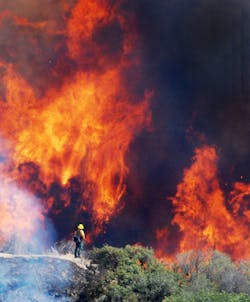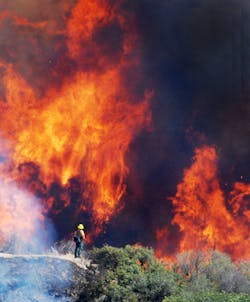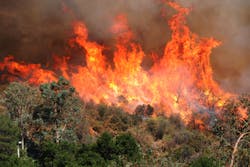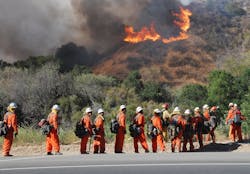The Camp Fire in northern California, November 2018, brought horrific images of raging fire in the wildland urban interface (WUI). As fire service professionals, we wonder about our readiness to deal with the challenges and chaos of wildfire as it threatens communities. The growing risk in the WUI requires we pause to reflect.
We are good at what we often do. Frequency builds familiarity. We are rightfully proud of our departmental and individual expertise. As we meet the needs of citizens, fire departments have established expertise in a variety of areas, for example, designating “Special Operations” duties including hazardous materials, urban search and rescue, technical rescue, swiftwater rescue, etc. Fire departments spend their time providing important citizen services, but in most places in the United States, not on large unplanned, unwanted, wildland fires. The future portends a different reality. Wildfire operations will be a significant component of the next decade; indeed, you face a future in flames.The changing interface
When you respond to a wildfire, you will likely be deployed to the interface. Communities and wildfires are more frequently colliding. The space where wildlands and homes and communities exist has been called the “I-Zone” or the “Urban interface,” but in most cases, it is known as the WUI. It is a place where traditional wildland firefighters will be coming to deal with the fire and where you will be heading to meet those wildland firefighters.
A group of state and federal agencies defines WUI as “The line, area, or zone where structures and other human development meet or intermingle with undeveloped wildland or vegetative fuels.”
In the continental United States, and in much of Alaska and Hawaii, the deadliest and fastest growing fuel type is the combination of vegetation and homes. About 1 in 3 homes in the lower 48 states are in or near the WUI. A study published by the National Academy of Sciences last year shows the number of houses located in urban-wildland interfaces across the U.S. increased by 12.7 million, or 41 percent, between 1990 and 2010.The presence of homes increases the spread of a wildfire once it has started, in part because housing materials, such as wood shakes, can be highly flammable. A burning home is a major source for hot embers, which can travel through the air and help spread wildfires.
The size and duration of these WUI fires are much different from the wildfires that communities have generally experienced. In this new era of “mega fires,” western wildfires nearly half the size of the state of Rhode Island occur every year. Fires move quickly with flaming fronts in grass racing along as fast as 10–15 mph and in forests up to 5 mph.
These mega fires can last weeks and the typical duration of an individual assignment for a firefighter is up to two weeks.
During every assignment, you will be most concerned about protection of life. Human lives lost or injured in the course of a wildfire are an incalculable societal cost. In the most extreme case to date in North America, the 1871 Peshtigo Fire killed more than 1,200 people, destroyed numerous settlements, and burned 2,400 square miles (about the size of the state of Delaware) across Wisconsin and Michigan. Just last year, civilian losses to wildfire were nearly 100, structures lost to wildfire exceeded 18,000, and insured losses neared $20 billion.
In the WUI, firefighting experts from the city and from the wildland meet. The discussion about mixing missions in the after-action report of the devastating 2018 Mendocino Complex fires in North California is illuminating. “The reality of the year-round fire season is that metropolitan fire departments will assist more and more in large wildfire suppression.”
Small, combination, and volunteer departments face special challenges. The National Fire Protection Association (NFPA) estimated that in 2010, 86 percent of the 26,000 local fire departments with over 1.1. million firefighters had wildland fire suppression duties, and many were staffed primarily by volunteers.
NFPA investigated needs in the WUI and reported (in part) in January 2017 inconsistent adoption of wildland/WUI fire training, with local and regional variations in the level, and adequacy of training and firefighter fitness levels not always be adequate for the rigors of wildland/WUI fire events.
The challenges for all firefighters will be extensive. Federal wildland fire agencies manage public lands over hundreds of millions of acres in the United States. Those agencies have done long-range thinking about the nation’s wildfire issues. For example, they noted in a “Quadrennial Fire Review” in 2014, “These issues are expected to become more acute as climatic change exposes new areas of the country...to wildfire.”
Additionally, they noted, climate projections indicate that the number of acres burned by wildfire in the United States could quadruple from approximately 5 million to some 20 million acres by 2050.
Firefighter deaths and injuries
Unlike cities where focus, codes, training, hard work and leadership have significantly reduced firefighter and civilian deaths, there has been no such accomplishment in the wildland environment. They burn with increasing frequency and risk. In just these last few years, high-profile wildland fires have resulted in multiple firefighter deaths. In 2013, during the Yarnell Hill fire, 19 highly trained wildland firefighters died. July 2019 will mark the 25th anniversary of the South Mountain fire where 14 firefighters died on Storm King mountain near Glenwood Springs, CO (see story on page XX).
Despite the notoriety of those tragedies, wildland fire fatalities and injuries occur disproportionately among firefighters whose primary mission is not wildland firefighting. For example, in 2016, nearly one-third of the firefighters who died in the line of duty while fighting wildland fires were not from traditional wildland fire agencies.As noted in a comprehensive study of wildland firefighter deaths, the most common causes of death are aviation accidents, vehicle accidents, medical events, and entrapments/burnovers.
That same study showed that males over the age of 40 (55–56 percent), and volunteers (27–33 percent) accounted for the most fatalities.
The leading cause among volunteer firefighter deaths was medical events. Even for those who specialize in wildland fire (generally federal or state workers) entrapment/burnovers were the leading cause of death. The leading problems for career firefighters were medical events and vehicle-related incidents.
Finally, in perhaps the most sobering sentences of that study, the scientists concluded, “linear regression analysis indicated that the deaths … did not show a statistically significant trend from 2001–2012.” In my words, we’ve made no substantive progress.
Considering all we have done with the prevention of fire, and reduction of firefighter deaths in America, wildland fires remain a very wicked problem.
Our profession is developing tools for use in the WUI. The International Association of Fire Chiefs (IAFC) developed the “Ready Set Go” program and a Chiefs guide for operation in the WUI.
The International Association of Firefighters (IAFF) is developing specific training for the Wildland Urban Interface.
The National Fallen Firefighters Foundation (NFFF) has developed Everyone Goes Home in the Wildland. Additionally, under the leadership of their respective organizations, the NFFF and the Wildland Firefighter Foundation have pledged on going cooperation and coordination to stem the epidemic of wildland firefighter accident, injury, and death.
Ongoing efforts, which target fitness, like the Health Wellness (IAFC IAFF) are applicable to the WUI. The NFFF “Seat Belt Pledge” is highly applicable in the wildland.
Improving technology, especially the type of technology that will encourage the firefighter to think, will allow improved situational awareness in the wildland.
The U.S. Forest Service is a leader in thinking about wildland risk management systems. They have issued several informative reports discussing wildland fire “risk.”
Firefighters indicate a need for knowledge and adaptation about the tasks, trials, and systems for firefighters who meet in the WUI. Fire departments could alert themselves to natural resource management through documents such as the wildland fire cohesive strategy. Wildland firefighters need additional skills to understand the language and tactics of their sisters and brothers who work in communities.
Because of their relationships and connections, individual state foresters and state wildland fire organizations are a great help in linking firefighters and preparing them for the challenges of the WUI.
We are good at what we do frequently, the future demands we be skilled at operations in the WUI. Yes, your future will be in flames. Our coordinated operations in the WUI can be a source of pride for us as we exceed the expectations of citizens and of our fellow professionals. It can also allow for everyone to go home after a job well done.
References
1 https://www.nwcg.gov/term/glossary/wildland-urban-interface-%28wui%29%C2%A0
2 Radeloff, V.C., Helmers, D.P., Anu Kramer, H. et al. “Rapid growth of the US wildland-urban interface raises wildfire risk,” PNAS March 27 (2018)
3 Ailworth, E., Wall Street Journal, U.S. edition, 10 May (2019_
4 wildfirelessons.net/HigherLogic/System/DownloadDocumentFile.ashx?DocumentFileKey=9c97da1c-0e28-968e-2f6e-d123f6cd182c&forceDialog=0
5 National Fire Prevention Association. Third Needs Assessment of the U.S. Fire Service.
nfpa.org/-/media/Files/News-and-Research/Fire-statistics-and-reports/Emergency-responders/Needs-Assessment/2011needsassessment.ashx?la=en
6 forestsandrangelands.gov/documents/qfr/2014QFRFinalReport.pdf
7 Ibid
8 Butler, C., Marsh, S., Domitrovich, J.W., and Helmpkamp, J. “); Wildland firefighter deaths in the United States: A comparison of existing surveillance systems,” J Occup Environ Hyg. 14:4 (2017) pp. 258–270.
9 Ibid
10 Ibid
11 Ibid
12 wildlandfirersg.org
13 iafc.org/topics-and-tools/resources/resource/WuiChiefsGuide
14 https://www.everyonegoeshome.com/2018/09/14/wildland
15 http://www.iaff.org/hs/wfiresource/default.html
16 https://www.everyonegoeshome.com/seatbelts
17 fs.usda.gov/treesearch
18 forestsandrangelands.gov
16 Firefighter Life Safety Initiatives for the Wildland Firefighters
1. Define and advocate the need for a cultural change within the fire service relating to safety; incorporating leadership, management, supervision, accountability and personal responsibility.
2. Enhance the personal and organizational accountability for health and safety throughout the fire service.
3. Focus greater attention on the integration of risk management with incident management at all levels, including strategic, tactical and planning responsibilities.
4. All firefighters must be empowered to stop unsafe practices.
5. Develop and implement national standards for training, qualifications, and certification (including regular recertification) that are equally applicable to all firefighters based on the duties they are expected to perform.
6. Develop and implement national medical and physical fitness standards that are equally applicable to all firefighters, based on the duties they are expected to perform.
7. Create a national research agenda and data collection system that relates to the 16 Firefighter Life Safety Initiatives.
8. Utilize available technology wherever it can produce higher levels of health and safety.
9. Thoroughly investigate all firefighter fatalities, injuries, and near-misses.
10. Grant programs should support the implementation of safe practices and procedures and/or mandate safe practices as an eligibility requirement.
11. National standards for emergency response policies and procedures should be developed and championed.
12. National protocols for response to violent incidents should be developed and championed.
13. Firefighters and their families must have access to counseling and psychological support.
14. Public education must receive more resources and be championed as a critical fire and life safety program.
15. Advocacy must be strengthened for the enforcement of codes and the installation of home fire sprinklers.
16. Safety must be a primary consideration in the design of apparatus and equipment.
Source: Everyone Goes Home
About the Author
Tom Harbour
Chief Tom Harbour is a recognized expert in wildland fire and aviation management policy and operations. He served the longest term to date as the National Fire and Aviation Management Director (National Fire Chief) of the USDA Forest Service, overseeing a program that employed over 10,000 firefighters, with an annual budget of nearly $4 billion. Since retiring, he has worked as a consultant offering expertise and advice on wildland fire issues as well as policy and organizational issues. He is now assisting the NFFF in work to reduce LODD, accident and injury among firefighters responding in the wildland and WUI environments. Harbour serves on the Board of the International Association of Wildland Fire as well as on the Advisory Board of the NFFF. He can be reached at [email protected].



